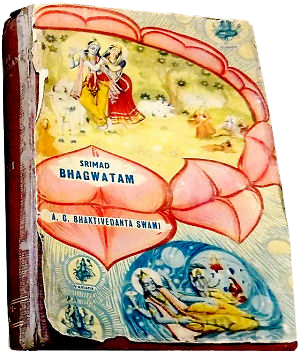 Harikesa, December 12, 1975, Vrndavana: So this idea of friction causing electricity, so is electricity—this electrical energy—the source of fire? That’s what the scientists think sometimes too, that the lightning bolt came down and made a fire. And that was man’s first experience of fire as a caveman.
Harikesa, December 12, 1975, Vrndavana: So this idea of friction causing electricity, so is electricity—this electrical energy—the source of fire? That’s what the scientists think sometimes too, that the lightning bolt came down and made a fire. And that was man’s first experience of fire as a caveman.
Aksayananda: So where did the lightning bolt come from?
Prabhupada: Yes. How the lightning was manufactured, rascal?
Harikesa: Well, there were some positive charges in the clouds and some negative charges in the ground.
Prabhupada: That’s alright. Who made that positive charge and negative charge?
Aksayananda: So let them manufacture lightning bolts in the Tata factory.
Prabhupada: How the electricity is produced unless there is some arrangement? Just put counter-argument and argument, try to understand. You have to preach. So your argument stopped?
“How does Lightning occur?”
Wikipedia: Lightning is an atmospheric discharge of electricity accompanied by thunder, which typically occurs during thunderstorms, and sometimes during volcanic eruptions or dust storms.[1] In the atmospheric electrical discharge, a leader of a bolt of lightning can travel at speeds of 60,000 m/s (130,000 mph), and can reach temperatures approaching 30,000 °C (54,000 °F), hot enough to fuse silica sand into glass channels known as fulgurites which are normally hollow and can extend some distance into the ground.[2][3] There are some 16 million lightning storms in the world every year.[4]
Lightning can also occur within the ash clouds from volcanic eruptions, or can be caused by violent forest fires which generate sufficient dust to create a static charge.[1][5]
Lightning can initially be formed by condensed water in clouds freezing into hail, then being blown by wind. The wind smashes the hail together, separating positive and negative charges. When enough negative charges build up, lightning is formed and strikes the tallest object near it.[citation needed]
How lightning initially forms is still a matter of debate:[6] Scientists have studied root causes ranging from atmospheric perturbations (wind, humidity, friction, and atmospheric pressure) to the impact of solar wind and accumulation of charged solar particles.[4] Ice inside a cloud is thought to be a key element in lightning development, and may cause a forcible separation of positive and negative charges within the cloud, thus assisting in the formation of lightning.[4]
The irrational fear of lightning (and thunder) is astraphobia. The study or science of lightning is called fulminology, and someone who studies lightning is referred to as a fulminologist. more







Speak Your Mind